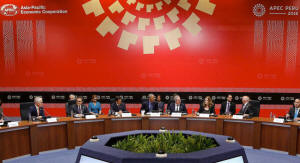|
After U.S. exit, Asian nations try to
save TPP trade deal
 Send a link to a friend
Send a link to a friend
 [January 24, 2017]
By Charlotte Greenfield and Stanley White [January 24, 2017]
By Charlotte Greenfield and Stanley White
WELLINGTON/TOKYO (Reuters) - Australia and
New Zealand said on Tuesday they hope to salvage the Trans-Pacific
Partnership (TPP) by encouraging China and other Asian countries to join
the trade pact after U.S. President Donald Trump kept a promise to
abandon the accord.
The TPP, which the United States had signed but not ratified, was a
pillar of former U.S. President Barack Obama's policy to pivot to Asia.
Japanese Prime Minister Shinzo Abe has touted it as an engine of
economic reform, as well as a counter-weight to a rising China, which is
not a TPP member.
Fulfilling a campaign pledge, Trump signed an executive order in the
Oval Office on Monday pulling the United States out of the 2015 TPP
agreement and distancing the United States from its Asian allies.
Australian Prime Minister Malcolm Turnbull said he had held discussions
with Abe, New Zealand Prime Minister Bill English and Singapore Prime
Minister Lee Hsien Loong overnight about the possibility of proceeding
without the United States.

"Losing the United States from the TPP is a big loss, there is no
question about that," Turnbull told reporters in Canberra on Tuesday.
"But we are not about to walk away ... certainly there is potential for
China to join the TPP."
In Beijing, Foreign Ministry spokeswoman Hua Chunying did not say
directly whether China would be interested in joining the TPP but that
at a time of economic uncertainly the Asia-Pacific should make its own
contributions to growth with openness.
"We think that in the present situation, no matter what happens, all
should keep going down the path of open, inclusive, continuous
development, seeking cooperation and win-win," Hua told a daily news
briefing.
Obama had framed the TPP without China in an effort to write Asia's
trade rules before Beijing could, establishing U.S. economic leadership
in the region as part of his "pivot to Asia".
China has proposed a counter pact, the Free Trade Area of the Asia
Pacific (FTAAP) and has championed the Southeast Asian-backed Regional
Comprehensive Economic Partnership (RCEP).
Hua said efforts on FTAAP should be stepped up, adding China hoped talks
on RCEP could be concluded at an early date.
MEETINGS PLANNED
New Zealand's English said the United States was ceding influence to
China and the region's focus could switch to alternative trade deals.
"We've got this RCEP agreement with Southeast Asia, which up until now
has been on a bit of a slow burn, but we might find the political will
for that to pick up if TPP isn't going to proceed," English said.
Malaysia's trade minister said negotiators from the remaining TPP
countries would be in "constant communication" to decide the best way
forward.
"Notwithstanding the current position of the new U.S. administration on
(TPP), we will continue to engage with our American colleagues to
strengthen our bilateral trade and economic relations, given the U.S.ís
importance as our third-largest trading partner and a major source of
investment," Mustapa Mohamed said in a statement.
The TTP, which has been five years in the making, requires ratification
by at least six countries accounting for 85 percent of the combined
gross domestic product of the member nations.
[to top of second column] |

President Barack Obama
holds meeting with Trans-Pacific Partnership (TPP) leaders at the
APEC Summit in Lima, Peru November 19, 2016. REUTERS/Kevin
Lamarque/File photo

Australia held open the possibility of China, the world's top
exporter, joining a revised deal.
"The original architecture was to enable other countries to join,"
Australian Trade Minister Steven Ciobo told the Australian
Broadcasting Corporation on Tuesday.
"Certainly I know that Indonesia has expressed interest and there
would be scope for China if we are able to reformulate it."
Japan has led the push for the partnership, which includes Brunei,
Canada, Chile, Malaysia, Mexico, Peru and Vietnam.
"There is no change to our view that free trade is the source of
economic growth," Japanese Economy Minister Nobuteru Ishihara told
reporters.
When asked whether Japan would be open to negotiating a bilateral
trade pact with the United States, Ishihara said it was uncertain
whether U.S. trade officials would start such negotiations.
Japanese Deputy Chief Cabinet Secretary Koichi Hagiuda said
separately that Japan was not considering moves with other TPP
members based on a lack of U.S. involvement.
"As Prime Minister Abe has made clear, TPP without the United States
is meaningless and the balance of interests would crumble," he told
a news conference, adding Japan would keep explaining the benefits
of the pact for America.
Abe had made TPP a core of his economic growth policies and along
with the Obama administration, viewed it as strategically vital in
the face of a rising China
Trump took office on Friday and pledged to end what he called an
"American carnage" of rusted factories and crime. He vowed to bring
jobs back by renegotiating what he called bad multilateral trade
deals in favor of bilateral ones.

New Zealand Trade Minister Todd McClay said he had talked with a
number of TPP-member ministers at the World Economic Forum in Davos
last week and he expected they would meet in coming months.
"The agreement still has value as a FTA (Free Trade Agreement) with
the other countries involved," McClay said in an emailed statement
to Reuters.
(Additional reporting by Swati Pandey in SYDNEY, Ami Miyazaki and
Linda Sieg in TOKYO, Liz Lee in KUALA LUMPUR and Ben Blanchard in
BEIJING; Editing by Lincoln Feast, Robert Birsel)
[© 2017 Thomson Reuters. All rights
reserved.]
Copyright 2017 Reuters. All rights reserved. This material may not be published,
broadcast, rewritten or redistributed. |